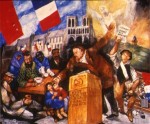 The international site of the Vincent dePaul Society features a study which says “(Ozanam)…was also the Vincent de Paul for the beginnings of the Industrial Revolution in France, and one of the forerunners of social Catholicism. ”
The international site of the Vincent dePaul Society features a study which says “(Ozanam)…was also the Vincent de Paul for the beginnings of the Industrial Revolution in France, and one of the forerunners of social Catholicism. ”
Although the Conference of Charity (1833) initially arose from a desire to unite in faith students from the provinces who had come to Paris, the gradual discovery by some of them of the “social issueâ€, that is poverty born of industrialisation, owed much to the visits they made to the tenements of the poor. Ozanam’s brother, a priest6, showed him the concept of the “lay
apostolate in the world†(1835). The Society of Saint Vincent de Paul7 was founded by lay people, was run by them, and did not involve the Church. This made it quite different from Pius XI’s Catholic Action. The historical debate over whether indeed Ozanam was “the†founder of the Society, is now concluded, with the merits of both parties, M. Bailly as well as Ozanam given their due recognition. The latter had the most profound concept of charity, and the personal visit to the poor as the point of mutual exchange, when both participants are recipients of the benefits. At one time professor of commercial law at Lyon (1841-1842) then involved in practical work arising from the revolutionary events of February to autumn 1848, this socially-aware Catholic (there were others), and democrat (much rarer) was searching for a third way, between economic liberalism, much too English to please him, and state interventionism, to which as a liberal he objected. But there must also be justice, and the Christian is a mediator between rich and poor. He therefore made his own proposals: graduated income tax, for which the Chambers would only vote in 1914 and free associations of workers, without deciding between a corporation and a trade union, a proposal taken up by Leo XIII in Rerum Novarum (1891).
Ozanam, who was won over to the idea of a Christian Republic, and who believed that the motto “Liberty, equality, fraternity” was inspired by the model of the early Church, was not in any way a socialist, since he saw socialism’s promise of happiness on earth as ignoring the reality of sorrow, sickness and death. Given industrial progress, and detecting already the beginnings of uniformity in products, dress and manners, he stood apart from both merciless critics and the blind admirers9. He clearly saw both faces of progress.
“Let us stand side by side with the poor”
The German painter and priest, Sieger Köder, painted a 4 by 4 wall mural in the Frederic Ozanam room in the St. Vincent parish church in Graz, Austria. With great sensitivity and ability, he portrayed the commitment of Frederic Ozanam (1813-1853), the founder of the Society of St. Vincent de Paul, to the poor.
Tags: Advocacy, Frederic Ozanam, mural
